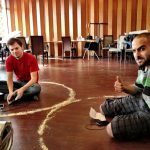Not long ago I went to Knutepunkt, the Nordic LARP convention held outside of Oslo. As I mentioned in a previous post, it was probably one of the single most transformative trips of my life. One of the reasons for that was the intense level of thought it forced me to put towards LARP design. It made me consider, among other things, why I love LARP more than other gaming forms. I came to the understanding through that week that I adore LARP because of it’s ability as an immersive, performative form to allow me to experience life through a different lens for a little while. It gives me experiential knowledge of being inside a simulated environment that is tactile, sense-based and interpersonal in a face-to-face setting. That to me makes LARP, above other kinds of roleplaying games, a special kind of interactive experience.
Yet one of the ideas brought up at Knutepunkt and later when I returned to the US was the idea that LARP could be a form of emotional tourism.
What does that term mean? Emotional tourism is the idea that a person steps outside of their comfort zone to go to another part of the world to ‘live’ for a little while in the boots of another person. Sometimes that can be benign, like going to couch surf on someone’s futon on the other side of the country to see how people live there (see: house or apartment swapping). Yet the negative use of the term emotional tourism usually is leveled at folks who will travel somewhere less prosperous in an effort to experience how other people less fortunate or more at risk live. People seek out these experiences to be shook up out of their comfort zone, to really feel what it’s like to not live a safe life, and can be considered exploitative, the mark of the privileged trying to assuage guilt rather than really learn anything. Examples I’ve heard bandied around are rich children going to tour refugee camps in foreign countries, or volunteering to build houses in impoverished areas while ‘roughing it’ with the locals for a little while.
The term emotional tourism interests me on a completely different level – isn’t it good to be trying to help other people, even for a little while? – but putting that question aside, I was perplexed by the idea that LARP might be considered emotional tourism. Are LARPs a way to emotionally experience something that you don’t have in your every day life? Yes, perhaps. So is that exploration then or exploiting situations that aren’t our own for recreation? And is it one or the other?
Let’s build a scenario: LARP organizers decide to do a game based on a real-world serious topic, such as the plight of immigrant workers in the United States. The idea of the game is to have players work through the confusion of giving up everything you knew to find a home in a new country, especially if you have to seek that new home by dangerous and illegal means. The issue is a hot button one, so the designers abstract the game. They make it about two no-name countries in a heavily industrialized cyberpunk future, in which a non-technological country is going bankrupt and people must flee to a better land where they can get jobs. Players play the game on a camp site on the edge of a small city and must cross the acres of land to reach a checkpoint into ‘the city’, living by their wits to survive and get to their new promised land. Through the experience, players emotionally get in touch with feelings of isolation, uncertainty, guilt and a myriad of other feelings while getting a look at big issues like bigotry, immigration, economic issues, violence and nationalism. At the end of the game, they walk away from the game with a new look at these topics, so closely mirroring real world concerns through a game setting.
Now, one could say that the players are signing up for a weekend of ‘fun’ to experience these things, and that optional sign up and the implication that the experience is recreation for the players makes the game somehow more exploitative. In the real world, folks who experience the race for a better life across the US-Mexican border aren’t doing it because it’s a ‘fun’ artistic experience they’re having on a weekend with their friends. Yet players of a LARP can opt in to the game atmosphere to get a taste of these situations as a recreational activity. If the events become too intense, there is always the option to step away and return to their everyday lives, a fact that those in the actual situation cannot do. Is it then exploitative to take these real-world scenarios and parrot them in games for the exploration of gamers?
The question isn’t for LARP alone. Games which mirror real world content, such as first person shooter war simulations, by the same token could be considered emotional tourism as players are given the opportunity to ‘feel’ what it’s like to be in a battle. Yet it’s the immersion and live element of LARP that makes the question more immediate. Where the controller and video screen creates a medium boundary between the player and the world they’re experiencing, a LARPer does not have that medium between them and experience. Therefore the emotional intensity level can be ramped higher due to direct interaction with the intense environment.
I feel like perhaps this is the reason why roleplaying games have focused so heavily on fantasy content for so long. It’s easier to discuss questions of real-world issues when given a separating medium between you and the content. It’s easier to talk about racism when discussing the hatred between elves and dwarves in Lord of the Rings, or questions of slavery when playing in a post-apocalyptic setting like Dystopia Rising. Without that filter, I believe people encounter a discomfort with engaging with these big problems, especially when it could be construed from the outside – or even the inside – as emotional tourism from a place of privilege.
My answer to the question of whether LARPs might be emotional tourism is simple: yes, they might be. But they don’t have to be. The idea behind emotional tourism being a bad thing comes down to a question of intent. First, players come to games for many different reasons. Sometimes, it’s to emotionally express or experience. Sometimes, it’s just to hit lizard folks in the noggin with a latex sword.* But even if a player does go to throw themselves into a role, the reasons behind it are not always for exploitation of the plight of real world people. A player might go to experience something that helps them explore themselves, their feelings, and a new atmosphere that teaches them rather than lets them get a vicarious thrill. It’s that difference – the educational experience versus the vicarious visceral one – that sets the line in my eyes between exploration and exploitation, and that keeps me from feeling uncomfortable with the notion of LARP being the negative kind of emotional tourism.
Is this a cut and dry answer? No, it’s almost identification by degrees. But with more ‘serious’ games being run by the year – thanks in no small part to the spread of the Nordic LARP and freeform traditions into other countries – we are seeing more real world topics being tackled in ways that are devoid of fantastical medium, or at least more thinly veiled than ever before. Designers must, in my opinion, carefully consider why they’re creating their games and how they are representing these real world issues so as to keep from treading over that fine line into exploitative territory. Emotional experience is not a bad thing on its own – like many other things, it all comes down to the design.
* (Just kidding folks – don’t hit people in the head, that’s generally frowned upon).






